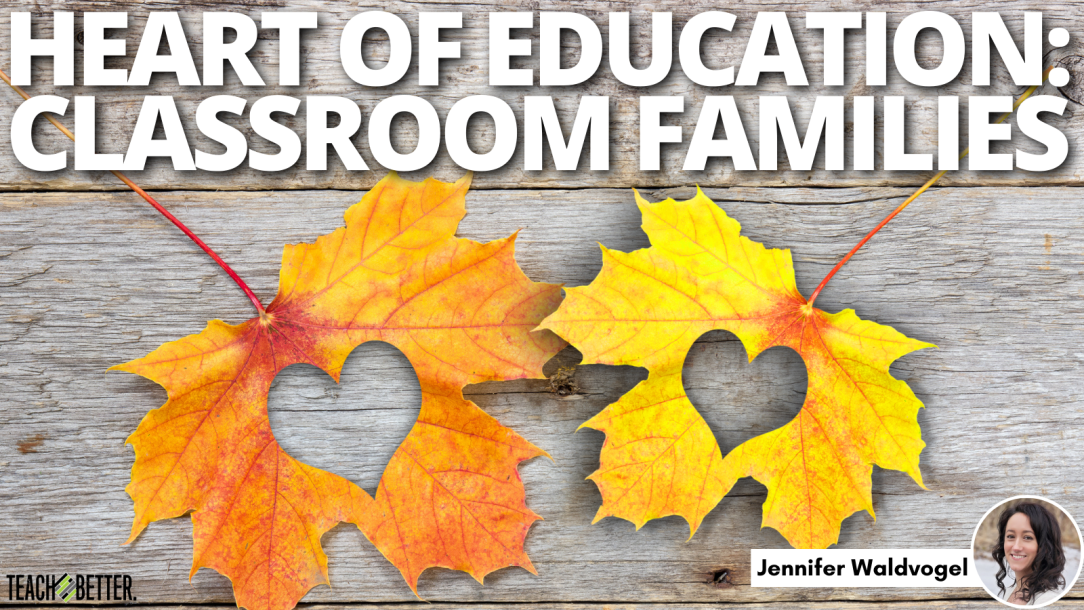TL;DR:
- Children may have a hard time recognizing their talents and skills.
- Educators can build students’ conflict resolution toolkit with stress reduction tools and empathy practice.
- Open each class with an activity that grounds students into the present moment.
There’s a reason educators call students their “kids.” If schools are microcosms of society, then the classroom is a representation of family. Just like home families, classroom families work best when they take time to enjoy, respect, and learn from one another. In this season of family togetherness, we can offer students a warm, safe space in their classrooms. Acceptance and personal connections in school are critical because many students face great challenges in their personal lives. Looking to increase connection in the classroom? Here are four ways to strengthen the classroom family.
#1: Find the light in every child.
Kids have a hard time recognizing the way they’re perceived by others. I’m often surprised by what my own children have to say about the way they move and talk. As a mom, I see their layers and love each one. In the same way, the bright spots that seem obvious to us as educators can be blind spots for students. Yet, we can shine a light on the exact talents and skills we see by creating regular feedback loops among peers and from adult to student.
To build a positive feedback cycle, set one day a week for small group storytelling. Provide an easy, personal prompt 1-2 days prior to the talk so students can prepare their story and bring an artifact. Story prompts are low-stakes, asking students about a fun outing with family or friends, a favorite book, or a travel souvenir. The goal is to help students talk about themselves and respond to their peers with 1 question and 1 positive comment.
Starting with heart saves time because when we address human needs prior to learning needs, the mind is ready. - Jen Waldvogel Click To Tweet#2: Bring all hands on deck.
Volunteering to speak in a discussion, lead an activity, or model a problem on the board are common scenarios in class. What’s less common is the number of students who step forward to participate. In some cases, the act of volunteering is the barrier; in others, public attention is the problem. We can involve our students in every class activity by breaking down whole class demonstrations and discussions into small group displays first. Allow students to present their ideas in pairs or groups of four. In math, bring several pairs to the board at the same time. This creates a safe space to check and display work for whole class conversation.
In small group tasks, ask each member to take on a different role. Students succeed as a team, needing each person to complete their task. Looking for a new way to create successful student groups? Divide students into small groups and give teams a low-stakes task to complete. Then, remix groups for a second task. While teams work, observe the dynamics of each grouping and each member, taking note of how students support and challenge one another. Determine unit groups after three to four task trials.
#3: Fight fair. 
Students are going to bicker with one another and resist the expectations we set. Conflict is normal, but that doesn’t have to make a classroom a combative space. It’s tempting to cut into an argument among children and eliminate the confrontation. But we can also intervene in a way that invites listening and resolution. Supporting student dialogue, the expression of feelings, and a recognition that it’s okay to be civil classmates rather than earnest friends helps students practice real-world dynamics in school and neighborhood groups. Couple this with regular exercises in anger management, stress reduction, and empathy to build students’ conflict resolution toolkit.
[scroll down to keep reading]#4: Start with heart.
We’ve all had days when showing up for work is a miracle. When our first thought waking up is about the moment we can return to bed. Kids have those days too; they’re just less equipped to talk about what they need. When we approach our classroom families with heart first, we can see the sharpness in students’ lives and offer learning with kindness and understanding. Warmth is disarming. When the manager I approach with a problem is genuine in her desire to help, the frustration I carried to the desk quickly fades. Starting with heart means approaching student frustration with the understanding that students carry emotions and challenges that have nothing to do with us. We take a breath, decode their words, and read between their tone.

Green Child Magazine. October 17, 2022
One way to promote the heart mindset is to begin each class with an activity that grounds students into the present moment. Try a rotation of mindfulness prompts for each day of the week. This can include mandalas for coloring, 3-minute meditations, thank you card writing, and wishing wells. During brain breaks, create opportunities for students to get to know their peers. Starting with heart saves time because when we address human needs prior to learning needs, the mind is ready.
It all comes back to community.
The environment we offer students is more than a physical space. Students can feel warmth and acceptance in each conversation, expectation, and interaction we design. Let’s continue to build classroom communities that hold joy and respect in the same vein as excellence.
About Jennifer Waldvogel
Jennifer Waldvogel fell in love with teaching because she’s an optimist at heart and believes the possibilities inside classrooms are endless. She currently serves as a Teacher on Special Assignment for Technology Integration in Yorkville District 115, working alongside students, teachers, school & district leaders to guide blended programming, design professional development, and coach personalized instruction.
Jen is a National Board Certified teacher who spent over a decade teaching writing and literature to high schoolers. After a transformative blended learning pilot, she shifted into the role of TOSA to support student success at a global level in Yorkville’s Teaching & Learning Department. Ever curious, Jen enjoys PD- if she had the time and money, she’d be in school forever- engaging in conferences and workshops, where she has presented at the local, state, and national level about learning pathways, personalized PD, mindfulness, blended learning, student motivation, and ways to maximize your LMS. She is honored to have been awarded the 2019 Illinois Computing Educator of the Year.
Jen holds a Bachelor’s from the University of Illinois (Psychology), Secondary Ed from North Central College (Language Arts), and Master’s from Northern Illinois University (School Counseling). Publications include Midwest Poetry Review, The Storyteller Magazine, Educational Leadership (2019), and Ideas to Connect Your Classroom (2020). Jen is also a published novelist, Untouchable (2016), who blogs at jenniferwaldvogel.com.
Jen is a proud wife and mom, enjoying hiking, travel, and foodie adventures with her family. She loves Walt Whitman, Key West, and music you can dance to. Writing is her favorite hobby. You can find her on FB and Instagram @jennifer_waldvogel_author.




